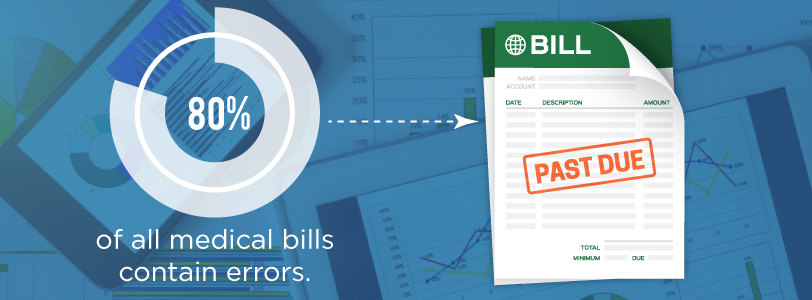Recent changes to the U.S. healthcare system have brought about a variety of new challenges for providers and patients alike. Many aspects of healthcare reform, like the introduction of more time-consuming, value-based compensation models, and the frequent alterations of billing rules and regulations, can cause revenue losses for providers across the United States. Failure to stay up-to-date on medical billing rules and regulations, in addition to billing errors, results in U.S. medical providers leaving approximately $125 billion in uncollected revenue each year. Specialists like radiologists face even greater challenges due to the complexity of their procedures rendered and requisite billing needs.
Simultaneously, patients’ ability to pay their bills is declining. Patients experienced a 150% increase in deductible costs from 2009-2018, and according to a Commonwealth Fund survey, only 62% of adults are somewhat confident in their ability to afford health care. In addition to increasing deductibles, the average out-of-pocket costs have increased about 71% over the past 10 years. An average family typically spends $6,015 out-of-pocket each year.
How To Maximize Medical Practice Revenue
Though the data paints a dismal picture of the financial health of the industry, there is hope for healthcare providers. To mitigate practice financial issues and compliance risks, medical practices are taking a more proactive approach to their billing procedures. Preventing problems before they happen can maximize medical practice revenue, ensure proper reimbursement, and allow medical practices to continue providing care to their communities.
Here are several steps your healthcare practice can take to better manage medical billing and be proactive:
1. Establish a Clear Collections Process
All providers need a collections process to ensure the financial health of their practice. Establishing a step-by-step approach clarifies the procedures for all involved, and it can greatly improve revenue cycles by ensuring patients are properly and thoroughly informed of their responsibilities.
All collections processes should involve a few steps:
- Establish clear terms: Inform patients of what’s expected of them when it comes to paying their debts. Include text about their responsibility to pay as part of their new-patient paperwork and regularly remind them of their obligations, especially when changes occur. This way, they can’t claim ignorance as a reason for delinquency. This can be especially challenging for practices with less face-time between patients and practitioners, such as radiology practices, as it leaves more room for patient misunderstandings.
- Collect patient information: Retrieve as much information as possible about patients, including their address, phone number, email, workplace, etc. Be sure to require a photo ID at a patient’s first visit — this is crucial if a bill needs to be sent to a collections agency down the line.
- Verify addresses: Check with patients regularly to ensure they haven’t changed their address or contact information. It’s important to know how to reach patients so time and money is not wasted sending mail to bad addresses or calling outdated numbers.
- Get permission to leave messages: Include an agreement within new-patient paperwork that allows messages to be left on their voicemail regarding billing matters.
- Remind patients about co-pays: When speaking with patients, remind them about their co-pay and why it’s important. Be sure staff is trained on this as well so they can answer any questions a patient might have.
- Verify eligibility regularly: Retrieve the insurance card and verify patient eligibility with every visit to avoid claim denials. Even better, use an automated verification system to save on labor costs.
- Collect up front: Collect co-pays and balances due based on their deductibles up front to avoid the paperwork and labor involved in chasing it down later.
- Payment options: Immediately establish what payment options are available to the patient. Be clear about what the payments cover, whether credit cards, checks, or cash are acceptable, as well as if payment plans are available.
- Letters: Write a sequence of letters to send out to patients when their bill is coming due, is overdue, or is about to be sent to collections. Some people need several reminders before acting, and a physical letter carries more psychological weight than a voicemail message.
Specialties like radiology may need to change certain parts of this process to better suit their business, primarily because they’re less likely to see a patient face-to-face to discuss billing responsibilities. In this case, procedures must focus more on new-patient orientation, validation, and notification rather than discussion.
Though this process is detailed and time-consuming to start, implementing a standard collections process can help healthcare providers collect reimbursement more quickly, better identify when to send a bill to collections, and eliminate lack of communication or knowledge as a reason for patient delinquency.
2. Manage Claims Properly
Approximately 80% of all medical bills contain errors, and because of how strict insurance companies are about correct medical billing and coding practices, they’ll likely be rejected. The cycle of submission, rejection, editing, and resubmission can take weeks, often resulting in providers waiting for months before receiving payment for their services.
Because of the wasted time and effort involved in editing and resubmitting claims, it’s important that claims are accurate and complete the first time. This involves inputting the information correctly and double-checking claims for any possible errors before submitting them.
Some of the most common sources of error include:
- Incorrect patient information: Name, date of birth, insurance ID number, etc.
- Incorrect provider information: Address, name, contact information, etc.
- Incorrect insurance information: Policy number, address, electronic payer ID, etc.
- Duplicate billing: Failure to verify that a service has already been reported or reimbursed.
- Poor documentation: The provider submitted an incorrect, illegible, or incomplete documentation of a procedure or visit, making it more difficult to verify and complete the claim. In these cases, the biller should contact the provider for more information.
- No EOB on a denied claim: For insurers still requiring physical claims, they may fail to attach the Explanation of Benefits (EOB) to a denied claim, making it more difficult to spot and correct the error.
- Missing or unclear denial codes or claim number references on a denied claim: Many insurers allow electronic or online submissions of appeals and corrected claims. Instead of an EOB, these claims are returned with a claim number and denial codes to explain the source of error. If these codes are missing or unclear, it can be more difficult to spot and correct the error.
To minimize billing problems, be sure to double-check claims before submitting them and communicate with the rendering provider if any information is inconsistent, incomplete, or unclear. After submitting the claim, follow up with a representative of the insurance company and keep up-to-date on any errors they may have encountered.
When resubmitting a denied claim, make sure to check the attached Explanation of Benefits (EOB) in addition to the possible errors listed above. It’s possible that an insurance company will return a claim without an EOB or denial code attached, which makes it more difficult to identify and correct any errors. If this occurs, contact a representative of the company to ask if they can clarify which portions of the claim were problematic or if they can send the EOB.
3. Minimize Coding Errors
Within a claim, medical coders describe the performed procedures using standardized codes, making the claims easier to decipher and process. These codes can use ICD-10-CM, CPT and HCPCS Level II classification systems.
While this provides a standard method of describing procedures, errors can still occur. The most common errors, such as incorrect, mismatched, or missing codes, are often caught by clearinghouses before they become an issue. However, some common errors are more difficult to catch. These errors include:
- Non-specific diagnosis codes: ICD-10 requirements for diagnosis documentation are much more detailed than the previous ICD-9 requirements. Because of these more stringent requirements, one of the more common issues in medical coding is insufficient diagnosis codes. This involves capturing new information about the patient’s condition that the practitioner never documented before, including updates on their condition. This can often be fixed by improving the quality of initial data collected about the patient from the referring physician.
- Incorrect modifiers: Incorrect modifier usage is the second most common reason for lost reimbursement in radiology practices. In these cases, the wrong modifier is added to a claim or a required modifier was missing from the claim. These modifiers often depend on the requirements of the payer. Using the correct modifiers can be the difference between a full or reduced reimbursement or denial.
The items listed above are the most frequent sources of coding errors however, other potentially problematic errors do occur as well. These include upcoding and undercoding, which can be intentional or accidental sources of error:
- Upcoding: Adding or exchanging certain codes with the codes for more expensive procedures. This can happen as the result of miscommunication between the coder and the provider, or it can happen intentionally (which is illegal).
- Undercoding: Omitting or exchanging certain codes with the codes for less expensive procedures. This can happen as the result of miscommunication between the coder and the provider, or it can happen when a provider intentionally leaves out or changes a procedure from a bill.
Always double-check codes before submitting a claim. If a procedure description is contradictory or ambiguous, contact the provider before assigning a code to avoid upcoding or undercoding. If in doubt, cross-check with medical coding resources to ensure the correct code is being used.
4. Promptly Handle Denied or Rejected Claims
To discuss this topic in detail, it’s important to establish the differences between a rejected claim and a denied claim.
A rejected claim is one that hasn’t been processed yet due to the discovery of one or more errors. It’s preventing the insurance company from paying the bill as it’s written. A denied claim, on the other hand, is a claim that the insurance company has processed and has deemed unpayable due to a discovered violation of the payer-patient contract or some vital error caught after processing. In both of these cases, the payer will return the claim to the biller with an explanation of the problem. A rejected claim can be corrected and resubmitted, but a denied claim must be appealed before resubmission, a much more costly and time-consuming process.
Checking for errors in a claim can minimize the occurrence of rejections and denials, but if they do occur, be sure to handle them as quickly as possible. Keep in touch with a representative of the payer — they can help clarify problems with the original claim and provide information on current claims as they are processed. All of this can help expedite the claim editing process and minimize appeal and resubmission times.
5. Look for Ways to Improve
The healthcare field is constantly changing, and physician practices should follow suit if they want to maximize efficiency and revenue. By tracking performance and keeping current on the latest healthcare regulations, practices can identify problem areas and implement new ways of addressing them.
To ensure optimum efficiency and accuracy, physician practices should take the following steps:
- Track pending accounts receivable: The outstanding money owed to a healthcare institution is an important figure to track to determine the effectiveness of their collection procedure. Tracking this amount from quarter to quarter and comparing these figures to those of the previous year are excellent ways to determine how efficiently a practice’s revenue cycle is performing. Such an analysis can also help determine the impact of any newly implemented procedures.
- Stay informed: Medical billing rules are constantly changing and keeping up with these changes can require continuing education and training for staff, as well as software updates. Stay on top of any changes that may affect billing and coding protocols and seek training if necessary — this is less costly in the long run than repeatedly resubmitting claims.
- Identify problem accounts: Establishing clear procedures for handling patient accounts means that data will become available to aid in the identification of potential challenges. Implement ways of tracking problematic behaviors like late payments, regularly declined payments, or frequent changes in contact information to better target such patients for additional reminders and prepare billing personnel to outsource to collections.
6. Know When to Outsource Medical Practice Billing
Medical practices must constantly worry about their patients, current trends in medicine and proper staff management. They must also stay current with the most recent rules about coding standards, insurance companies, and billing regulations. With so much to keep up with, details can slip through the cracks, resulting in rejections, denials, and underpayments that cost medical practices time and money.
Despite their best efforts to implement proactive billing practices, many healthcare providers still find themselves lagging behind. This is often due to the costly time and labor involved in tracking down debtors, submitting and editing claims, and staying on top of current regulation — duties often piled on top of the existing responsibilities of medical office staff.
In response to the multiplying rules and regulations and in an effort to cut labor costs, many practices have outsourced their medical billing and coding to third party specialists. For many, letting another party manage their medical billing is an effective way to increase revenue and regain control.
Some of the benefits of outsourced medical billing include:
- Dedicated specialists: Medical billing and coding companies have dedicated staffs of medical billing specialists, whose sole job is to ensure that claims are filed correctly and denied claims are resubmitted properly. Because of their specialized experience and duties, they can pay attention to the minutiae medical office employees can miss in the bustle of their daily duties.
- Fast submissions: Highly trained staff members can submit claims much more quickly and with greater attention to detail.
- Greater focus on patients: Once they’ve eliminated the time spent on billing and staffing concerns, doctors and nurses can better focus on their patients.
- Up-to-date standards: Medical billing companies are compliant with the most recent health care laws, and they are required to stay up-to-date with the most current regulations in order to meet the changing demands of serving hospital-based specialty practices.
Trust Healthcare Administrative Partners For Your Medical Billing and Coding
Outsource your medical billing to Healthcare Administrative Partners (HAP). Ask our clients, and they’ll tell you we’re one of the best medical billing and coding companies in the industry. We know the intricacies of revenue cycle management services for specialty hospital-based physician practices and academic practice plans like few others in the business.
HAP consists of experts in professional component billing and coding services with decades of experience, delivering consistent results to clients of many medical specialties with greater efficiency and expertise than most in-house billing personnel can provide. We understand the intricacies of successful billing practices for services rendered by radiology practices.
Additionally, we strive to improve all areas of a medical practice’s financial health. By maximizing reimbursements and minimizing costs and compliance risks, we help deliver more of the revenue your practice deserves.
Implementing proactive billing procedures does take time and resources, but it pays off with increased cash flow, more efficient office operations, and ultimately a better overall experience for patients. By introducing these billing tips into your healthcare practice, you can expedite revenue cycles and position your practice for success in the modern healthcare economy.
If your healthcare practice is under strain from delinquent accounts and overloaded with pending and rejected claims, contact us today to speak with one of our specialists about the benefits of outsourced billing management.











